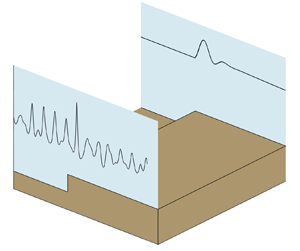Crossref Citations
This article has been cited by the following publications. This list is generated based on data provided by
Crossref.
Li, Yan
2021.
Three-dimensional surface gravity waves of a broad bandwidth on deep water.
Journal of Fluid Mechanics,
Vol. 926,
Issue. ,
Li, Yan
and
Li, Xin
2021.
Weakly nonlinear broadband and multi-directional surface waves on an arbitrary depth: A framework, Stokes drift, and particle trajectories.
Physics of Fluids,
Vol. 33,
Issue. 7,
Steer, James N.
Kimmoun, O.
and
Dias, F.
2021.
Breaking-wave induced pressure and acceleration on a clifftop boulder.
Journal of Fluid Mechanics,
Vol. 929,
Issue. ,
Kimmoun, Olivier
Hsu, Hung-Chu
Hoffmann, Norbert
and
Chabchoub, Amin
2021.
Experiments on uni-directional and nonlinear wave group shoaling.
Ocean Dynamics,
Vol. 71,
Issue. 11-12,
p.
1105.
Zhang, Jie
Benoit, Michel
and
Ma, Yuxiang
2022.
Equilibration process of out-of-equilibrium sea-states induced by strong depth variation: Evolution of coastal wave spectrum and representative parameters.
Coastal Engineering,
Vol. 174,
Issue. ,
p.
104099.
Ma, Yuxiang
Zhang, Jie
Chen, Qunbin
Tai, Bing
Dong, Guohai
Xie, Botao
and
Niu, Xuyang
2022.
Progresses in the Research of Oceanic Freak Waves: Mechanism, Modeling, and Forecasting.
International Journal of Ocean and Coastal Engineering,
Vol. 04,
Issue. 01n02,
Mendes, Saulo
and
Kasparian, Jérôme
2022.
Saturation of rogue wave amplification over steep shoals.
Physical Review E,
Vol. 106,
Issue. 6,
Mendes, S.
Scotti, A.
Brunetti, M.
and
Kasparian, J.
2022.
Non-homogeneous analysis of rogue wave probability evolution over a shoal.
Journal of Fluid Mechanics,
Vol. 939,
Issue. ,
Monsalve, Eduardo
Maurel, Agnès
Pagneux, Vincent
and
Petitjeans, Philippe
2022.
Nonlinear Waves Passing over Rectangular Obstacles: Multimodal Method and Experimental Validation.
Fluids,
Vol. 7,
Issue. 5,
p.
145.
Lawrence, Christopher
Trulsen, Karsten
and
Gramstad, Odin
2022.
Extreme wave statistics of surface elevation and velocity field of gravity waves over a two-dimensional bathymetry.
Journal of Fluid Mechanics,
Vol. 939,
Issue. ,
Li, Yan
and
Chabchoub, Amin
2023.
On the formation of coastal rogue waves in water of variable depth.
Cambridge Prisms: Coastal Futures,
Vol. 1,
Issue. ,
Lyu, Zuorui
Mori, Nobuhito
and
Kashima, Hiroaki
2023.
Freak wave in a two-dimensional directional wavefield with bottom topography change. Part 1. Normal incidence wave.
Journal of Fluid Mechanics,
Vol. 959,
Issue. ,
Gaidai, Oleg
Xing, Yihan
and
Xu, Xiaosen
2023.
Novel methods for coupled prediction of extreme wind speeds and wave heights.
Scientific Reports,
Vol. 13,
Issue. 1,
Gaidai, Oleg
Xu, Jingxiang
Yan, Ping
Xing, Yihan
Wang, Kelin
and
Liu, Zirui
2023.
Novel methods for reliability study of multi-dimensional non-linear dynamic systems.
Scientific Reports,
Vol. 13,
Issue. 1,
Mendes, S.
and
Kasparian, J.
2023.
Non-homogeneous approximation for the kurtosis evolution of shoaling rogue waves.
Journal of Fluid Mechanics,
Vol. 966,
Issue. ,
Sun, Hui
and
Moore, Nicholas J.
2023.
On Normal and Non-Normal Wave Statistics Implied by a Canonical–Microcanonical Gibbs Ensemble of the Truncated KdV System.
Journal of Statistical Physics,
Vol. 190,
Issue. 1,
Li, Zhenhao
Tang, Tianning
Li, Yan
Draycott, Samuel
van den Bremer, Ton S.
and
Adcock, Thomas A. A.
2023.
Wave loads on ocean infrastructure increase as a result of waves passing over abrupt depth transitions.
Journal of Ocean Engineering and Marine Energy,
Vol. 9,
Issue. 2,
p.
309.
Wu, Qian
Feng, Xingya
Dong, You
and
Dias, Frederic
2023.
On the behavior of higher harmonics in the evolution of nonlinear water waves in the presence of abrupt depth transitions.
Physics of Fluids,
Vol. 35,
Issue. 12,
Teutsch, Ina
Brühl, Markus
Weisse, Ralf
and
Wahls, Sander
2023.
Contribution of solitons to enhanced rogue wave occurrence in shallow depths: a case study in the southern North Sea.
Natural Hazards and Earth System Sciences,
Vol. 23,
Issue. 6,
p.
2053.
Zheng, Zibo
Li, Yan
and
Ellingsen, Simen Å.
2023.
Statistics of weakly nonlinear waves on currents with strong vertical shear.
Physical Review Fluids,
Vol. 8,
Issue. 1,






